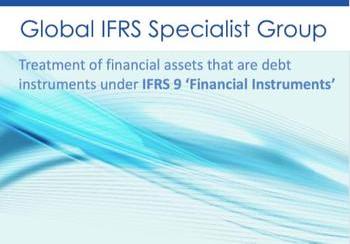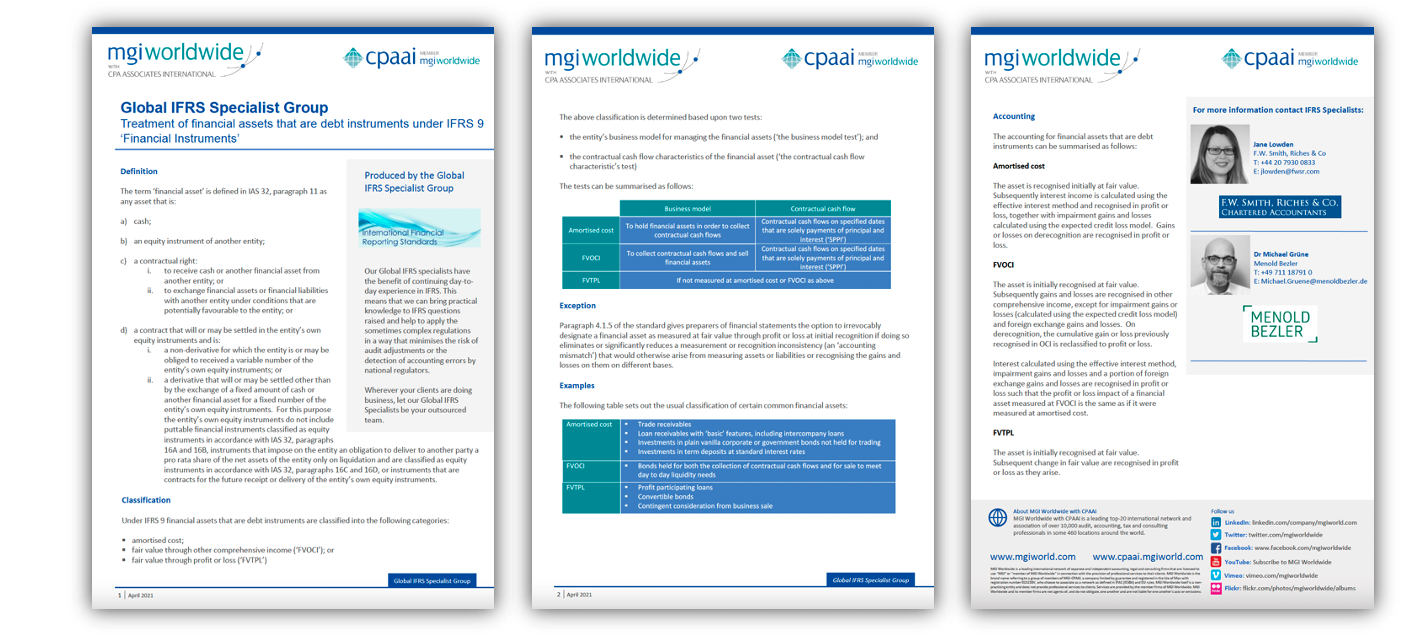Global IFRS Group reports on the Treatment of financial assets that are debt instruments under IFRS 9 ‘Financial Instruments'

In this, the latest white paper from our Global IFRS Group, Jane Lowden from F.W. Smith, Riches & Co, UK, and Dr Michael Grüne from Menold Bezler, Germany, take a look at the Treatment of financial assets that are debt instruments under IFRS 9 ‘Financial Instruments', considering their definition and classification and providing examples of the usual classification of certain common financial assets.
Definition
The term ‘financial asset’ is defined in IAS 32, paragraph 11 as any asset that is:
a) cashb) an equity instrument of another entity
c) a contractual right:
i. to receive cash or another financial asset from another entity; or
ii. to exchange financial assets or financial liabilities with another entity under conditions that are potentially favourable to the entity; or

d) a contract that will or may be settled in the entity’s own equity instruments and is:
i. a non-derivative for which the entity is or may be obliged to received a variable number of the entity’s own equity instruments; or
ii. a derivative that will or may be settled other than by the exchange of a fixed amount of cash or another financial asset for a fixed number of the entity’s own equity instruments. For this purpose the entity’s own equity instruments do not include puttable financial instruments classified as equity instruments in accordance with IAS 32, paragraphs16A and 16B, instruments that impose on the entity an obligation to deliver to another party a pro rata share of the net assets of the entity only on liquidation and are classified as equity instruments in accordance with IAS 32, paragraphs 16C and 16D, or instruments that are contracts for the future receipt or delivery of the entity’s own equity instruments.
Classification
Under IFRS 9 financial assets that are debt instruments are classified into the following categories:
- amortised cos
- fair value through other comprehensive income (‘FVOCI’); or
- fair value through profit or loss (‘FVTPL’)
The above classification is determined based upon two tests:
- the entity’s business model for managing the financial assets (‘the business model test’); and
- the contractual cash flow characteristics of the financial asset (‘the contractual cash flow characteristic’s test)

Exception
Paragraph 4.1.5 of the standard gives preparers of financial statements the option to irrevocably designate a financial asset as measured at fair value through profit or loss at initial recognition if doing so eliminates or significantly reduces a measurement or recognition inconsistency (an ‘accounting mismatch’) that would otherwise arise from measuring assets or liabilities or recognising the gains and losses on them on different bases.
Read the full white paper HERE
About MGI Worldwide with CPAAI's Global IFRS Specialist Group
Our Global IFRS specialists have the benefit of continuing day-to-day experience in IFRS. This means that we can bring practical knowledge to IFRS questions raised and help to apply the sometimes complex regulations in a way that minimises the risk of audit adjustments or the detection of accounting errors by national regulators.
Wherever your clients are doing business, let our Global IFRS Specialists be your outsourced team.
To learn more about the activities of the Global IFRS Specialist Group, or any of the other Groups, please contact International Business Development Manager, Nicki Lynn [email protected]
MGI Worldwide with CPAAI is a top 20 ranked global accounting network and association with 10,000 independent auditors, accountants and tax experts in some 460 locations in almost 100 countries around the world.
